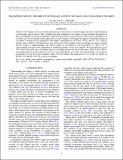Transiting the Sun : the impact of stellar activity on X-ray and ultraviolet transits
Abstract
Transits of hot Jupiters in X-rays and the ultraviolet have been shown to be both deeper and more variable than the corresponding optical transits. This variability has been attributed to hot Jupiters having extended atmospheres at these wavelengths. Using resolved images of the Sun from NASA’s Solar Dynamics Observatory spanning 3.5 yr of Solar Cycle 24 we simulate transit light curves of a hot Jupiter to investigate the impact of Solar-like activity on our ability to reliably recover properties of the planet’s atmosphere in soft X-rays (94 Å), the UV (131-1700 Å), and the optical (4500 Å). We find that for stars with activity levels similar to those of the Sun, the impact of stellar activity results in underestimating the derived radius of the planet in soft X-ray/EUV by up-to 25% or overestimating it by up to 50% depending on whether the planet occultsactive regions. We also find that in up to 70% of the X-ray light curves the planet transits over bright starspots. In the far-ultraviolet (1600 Å and 1700 Å), we find the mean recovered value of Rp/R* to be over-estimated by up to 20%. For optical transits we are able to consistently recover the correct planetary radius. We also address the implications of our results for transits of WASP-12 b and HD 189733b at short wavelengths.
Citation
Llama , J & Shkolnik , E L 2015 , ' Transiting the Sun : the impact of stellar activity on X-ray and ultraviolet transits ' , Astrophysical Journal , vol. 802 , no. 1 . https://doi.org/10.1088/0004-637X/802/1/41
Publication
Astrophysical Journal
Status
Peer reviewed
ISSN
0004-637XType
Journal article
Description
This work is supported by NASA Origins of the Solar System grant No. NNX13AH79G.Collections
Items in the St Andrews Research Repository are protected by copyright, with all rights reserved, unless otherwise indicated.

